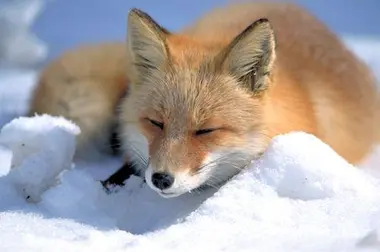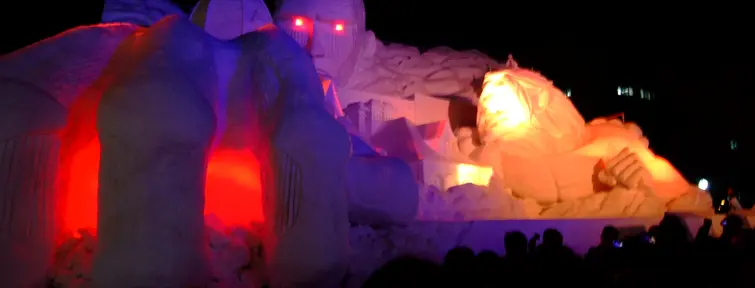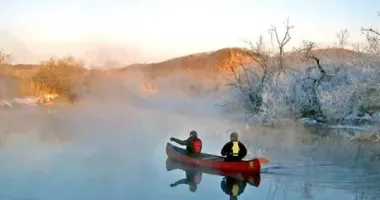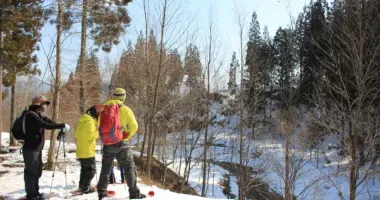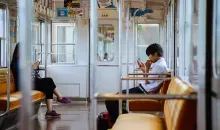Travelling to Japan in winter
- Published on : 03/12/2025
- by : Marion.E/Phoebe
- Youtube
With pleasant, dry, sunny weather, snow and low tourist numbers, winter is perhaps one of the best times to visit the Japanese archipelago.
Snow, onsens and festivals
Winter is the perfect time to admire Mount Fuji, which dons a more snowy cap, uncovered from its usual clouds. Japan's most beautiful sites, such as Kenroku-en in Kanazawa and Kinkaku-ji in Kyoto, are covered in a light blanket of snow, allowing you to visit them in complete tranquility. In winter, ume, the Japanese plum trees, bloom in February with a pale pink color, preceding the famous cherry blossoms.
Japan has become a top destination for ski enthusiasts, attracted by its exceptional snow conditions and magnificent scenery. Renowned resorts such as Niseko in Hokkaido and Hakuba on Honshu offer abundant powder and a ski season running from December to April, with peaks in January and February. Winter is also the ideal time to enjoy the Japanese hot springs known as onsen, especially the outdoor baths (rotenburo). What could be better than enjoying the benefits of hot water amidst steam or snow after a long day in the cold? The friendly atmosphere of the northern resorts and small villages, the delicious local cuisine and the snow festivals during this festive season make the winter experience unique in Japan.
- See also: 5 good reasons to visit Japan in winter
In the land of snow
To make the most of the winter season, head for Hokkaido, Japan's most northerly island, and the Japanese Alps, in the center of the country. These are the snowiest places, and therefore the two must-sees of the season! Tohoku is also a prime region for discovering the joys of winter.
Hokkaido, Japan's northern island
Visiting the island of Hokkaido in winter is like a polar excursion to the far north! With temperatures as low as -30 degrees, a thick blanket of snow and frozen lakes, Hokkaido is the perfect island to visit in winter for a unique winter experience. Mountains, volcanoes, plains, lakes, rivers, marshes, hot springs and magnificent national parks populated by wild animals... Hokkaido has what it takes! Renowned for its spa towns and winter sports resorts, discover some of its most beautiful winter landscapes!
Lake Akan
Located in the center of the island, Lake Akan offers an exceptional natural spectacle: the formation of delicate ice flowers on the surface of the lake. Once completely frozen, you can walk on the lake and even fish. It's also an opportunity to observe the black and white Japanese cranes, symbols of longevity and good fortune, which are only seen during this season.
Noboribetsu
Noboribetsu Onsen is a hot spot of volcanic activity, which can be approached to appreciate its full magnificence in the Jigokudani, the valley of the underworld. Its atypical landscape, with its orange hues and escaping vapors, immerses visitors in a unique atmosphere. The natural hot springs of Noboribetsu are the most popular in Hokkaido. Take a stroll through the village in search of the oni, the guardians of the underworld scattered throughout the town, and you're sure to come across a few bubbling geysers!
The village of Biei
The village of Biei holds many treasures. In spring and summer, come and enjoy its magnificent fields of flowers, especially lavender. In winter, don't miss the opportunity to visit the blue pond, Aoi ike. The surrounding countryside is cloaked in white, and the unreal blue of the pond creates a unique, magical atmosphere.
Shiretoko
At the eastern tip of the island of Hokkaido stretches one of Japan's most beautiful sites, Shiretoko, a fantastic natural conservatory home to brown bears, spotted seals, sperm whales and many species of birds, including eagles. It's the wildest place in Japan! At the height of winter, from late January onwards, a sea of floating ice forms right up to the horizon, which can be crossed by ice-breaking boat, the region's most popular attraction.
- Activity: Stroll on the Shiretoko ice floe
The Japanese Alps
With mountains rising above 3,000 meters, the Japanese Alps stand majestically between the Tokyo and Kyoto regions. Magnificent panoramas, challenging hikes, sensational skiing, hot springs and centuries-old villages... The Japanese Alps offer a wealth of activities and well-kept secrets.
Popularized by the 1998 Winter Olympics, Nagano is Japan's winter sports capital and the most important city in the Japanese Alps. It's also known for its famous Jigokudani monkey park, where macaques bathe in hot springs. Not far away, you'll find beautiful Kanazawa, passing through "little Kyoto", Takayama, and the famous village of Shirakawa-gô, whose thatched, snow-covered traditional houses are a UNESCO World Heritage Site.
Finally, if you visit the region, don't forget to bask in one of the many spa villages in the heart of the mountains, such as the small town of Shibu-Onsen, with its incredible traditional architecture, or Kinosaki-Onsen, one of Japan's oldest resorts, where you'll find a very relaxing atmosphere under the snow.
- All about : Japanese Alps
- How to get to : Nagano
This winter, hit the Japanese slopes with our tour!
Snow festival and illuminations, when snowflakes take center stage
A season marked by festivities, there's always something magical about Japan in winter. Especially when it's snowing! Ice sculptures, illuminations and even fireworks: the first snowflakes are often synonymous with festivities in the archipelago.
Yuki Matsuri: snow festivals
Yuki matsuri, or snow festivals, are a highlight of the winter season, particularly in the north of the country. The most famous of these is the snow festival in Sapporo, on the island of Hokkaido. Every year in February, over 250 snow and ice sculptures fill the city streets. The attraction of this festival lies above all in the staging of the sculptures, some of which exceed 15 meters in height, with a beautiful play of light! The artists' inspiration is boundless: fantastic animals, scenes from everyday life, frescoes and historical monuments, and even Japanese celebrities of the moment or even anime characters! Many other activities take place here, including concerts, sliding games and a delicious variety of stalls serving local specialities. It's a warm atmosphere that's a must-see!
Finally, if you visit the region, don't forget to bask in one of the many spa villages in the heart of the mountains, such as the small town of Shibu-Onsen, with its incredible traditional architecture, or Kinosaki-Onsen, one of Japan's oldest resorts, where you'll find a very relaxing atmosphere under the snow.
This winter, let yourself be tempted by our outdoor activities and discover Japan in a whole new way !
Oshôgatsu, the Japanese New Year
Winter is also a time of celebration, and while in Japan we don't necessarily celebrate Christmas, New Year's Eve, oshôgatsu お正月, on the other hand, is a very important time for families to get together and share warm moments. The religious dimension of Japanese syncretism is strong: it's a spiritual and family communion.
Even before the start of the New Year, the Japanese clean up their homes as well as their minds : tatami mats are shaken out, carpets aired, and it's a good omen to replace broken objects in order to best welcome the New Year's deities. All debts must be paid and all pending business concluded. Houses are decorated with kadomatsu, flower arrangements generally made of bamboo and pine, symbols of health and longevity.
Families savor toso, a spicy sake that guarantees good health, and prepare for prayers. Instead of the twelve strokes of midnight, the Japanese come to listen to the 108 strokes of the temple bell.
- Discover also : Hatsuhinode, a New Year Day tradition
These are supposed to dispel 108 passions or defilement and usher in the New Year. On this new day, going out at dawn to admire the sunrise is a symbol of happiness. In the Shinto cult, the deity of the New Year arrives with the first ray of the sun. A legend that prompts many Japanese to seek out elevated vantage points to make the most of the moment.
Last but not least, the most amusing custom of the new year is the surprise package known as fukubukuro. The principle is the same as in the West. Except that some can contain real treasures: a telephone, a computer, a trip, a car or even a house for the lucky ones!

To celebrate the New Year, Kobe's festivities begin on the morning of January 31 with a Chinese acrobatic dance performance.
Céline
Want to travel across Japan this winter? Consider the JR Pass to make getting around easier
The Japan Rail Pass (JR Pass) is a specialized ticket for visitors, allowing unlimited access to the Japan Rail network for a period of 7, 14 or 21 days. The Japan Rail Pass is the most economical and the most practical for those wanting to explore Japan by train.

N700 Shinkansen high-speed train on the Tokaido line
@Wikimedia
Nabe, sukiyaki, Shabu Shabu, those comforting Japanese-style stews
If winter is the season for pot-au-feu in France, in Japan it's the season for nabemono! A perfect blend of Chinese fondue and pot-au-feu, it comes in many regional variations. Traditional ingredients include Chinese cabbage, tofu, mushrooms, noodles (udon, kuzukiri, konjac noodles), fish and thin slices of meat (beef, pork), all cooked in a fish- or seaweed-based broth. In addition to nabe, discover sukiyaki, shabu shabu and oden, which are all kinds of pot-au-feu! Last but not least, don't forget to serve it all with hot sake, atsukan!
- Also read : Winter culinary specialities
Kotatsu, the warming table
Winter is also the time to curl up under a thick kotatsu, a heated coffee table covered with a thick blanket that stretches all around. With warm legs and a small cushion under the buttocks, you can read, watch TV or gather to share a good meal, a symbol of conviviality! For a long time, it was the centerpiece of washitsu (tatami-covered rooms) and often one of the only sources of heat in the home. If you're not lucky enough to have a kotatsu in your hotel, you can try them out in cafés and restaurants over the winter months.
- Find out more about : Kotatsu cafés and restaurants!
To find out more :
- Top winter activities in Japan
- The most beautiful Japanese landscapes under the snow
- Japanese winter specialities
- Top 7 snow festivals in Japan
- The best winter fireworks in Japan
- Otaru Snow and Light Festival
- Hanami under the plum blossoms
- 5 ways to enjoy Kyoto in winter
- 5 reasons to visit Japan in winter
- Where to go skiing near Tokyo?
- Where to admire cherry blossoms this winter?
- Where to see Japan's Snow Monsters?
- The best onsen in the Tohoku region
- The best rotenburo in winter
- Skiing in Japan
- The best winter road trips to do in Japan



